E-Commerce Business Analysis Report: Key Challenges and Benefits
VerifiedAdded on 2022/10/01
|15
|3742
|20
Report
AI Summary
This report provides a comprehensive analysis of e-commerce businesses, examining the reasons for their importance to organizations. It explores the various types of e-commerce models, including B2B, B2C, C2C, C2B, B2A, and C2A, and highlights the benefits such as global reach, lower costs, enhanced marketing, scalability, and improved consumer management. The report also identifies major challenges in e-commerce implementation, including verification issues, product returns, integration problems, and customer loyalty. The report emphasizes the need for organizations to understand and address these challenges to effectively leverage e-commerce for competitive advantage. The report also discusses the importance of digital marketing, consumer data analysis, and effective consumer management. The assignment is based on the BBED4103 E-Commerce module. The report aims to provide a comprehensive overview of e-commerce business, its benefits, challenges, and effective implementation strategies.

Running head: ANALYSIS OF E-COMMERCE BUSINESS
ANALYSIS OF E-COMMERCE BUSINESS
Name of student
Name of university
Author’s note:
ANALYSIS OF E-COMMERCE BUSINESS
Name of student
Name of university
Author’s note:
Paraphrase This Document
Need a fresh take? Get an instant paraphrase of this document with our AI Paraphraser
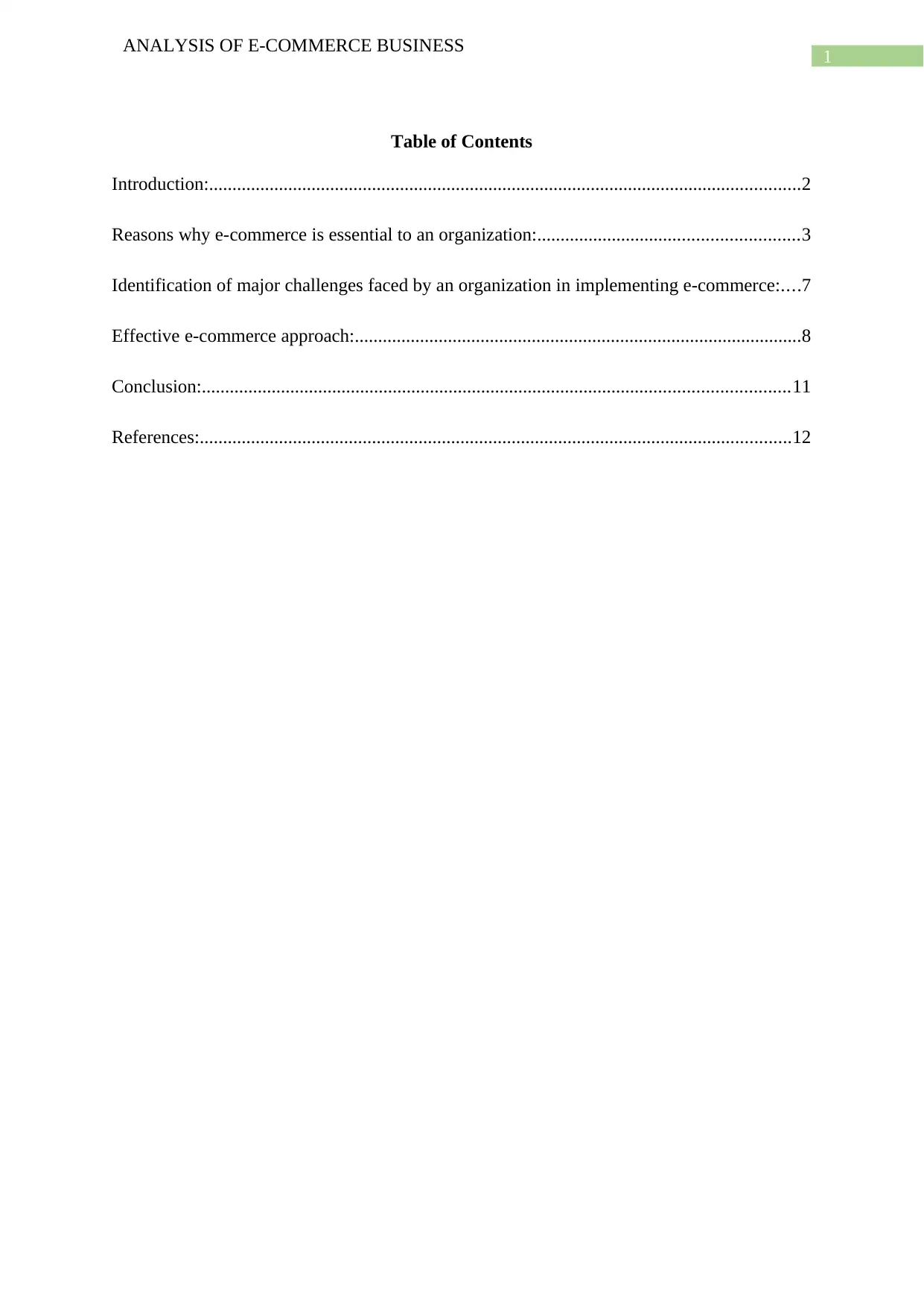
1
ANALYSIS OF E-COMMERCE BUSINESS
Table of Contents
Introduction:...............................................................................................................................2
Reasons why e-commerce is essential to an organization:........................................................3
Identification of major challenges faced by an organization in implementing e-commerce:....7
Effective e-commerce approach:................................................................................................8
Conclusion:..............................................................................................................................11
References:...............................................................................................................................12
ANALYSIS OF E-COMMERCE BUSINESS
Table of Contents
Introduction:...............................................................................................................................2
Reasons why e-commerce is essential to an organization:........................................................3
Identification of major challenges faced by an organization in implementing e-commerce:....7
Effective e-commerce approach:................................................................................................8
Conclusion:..............................................................................................................................11
References:...............................................................................................................................12
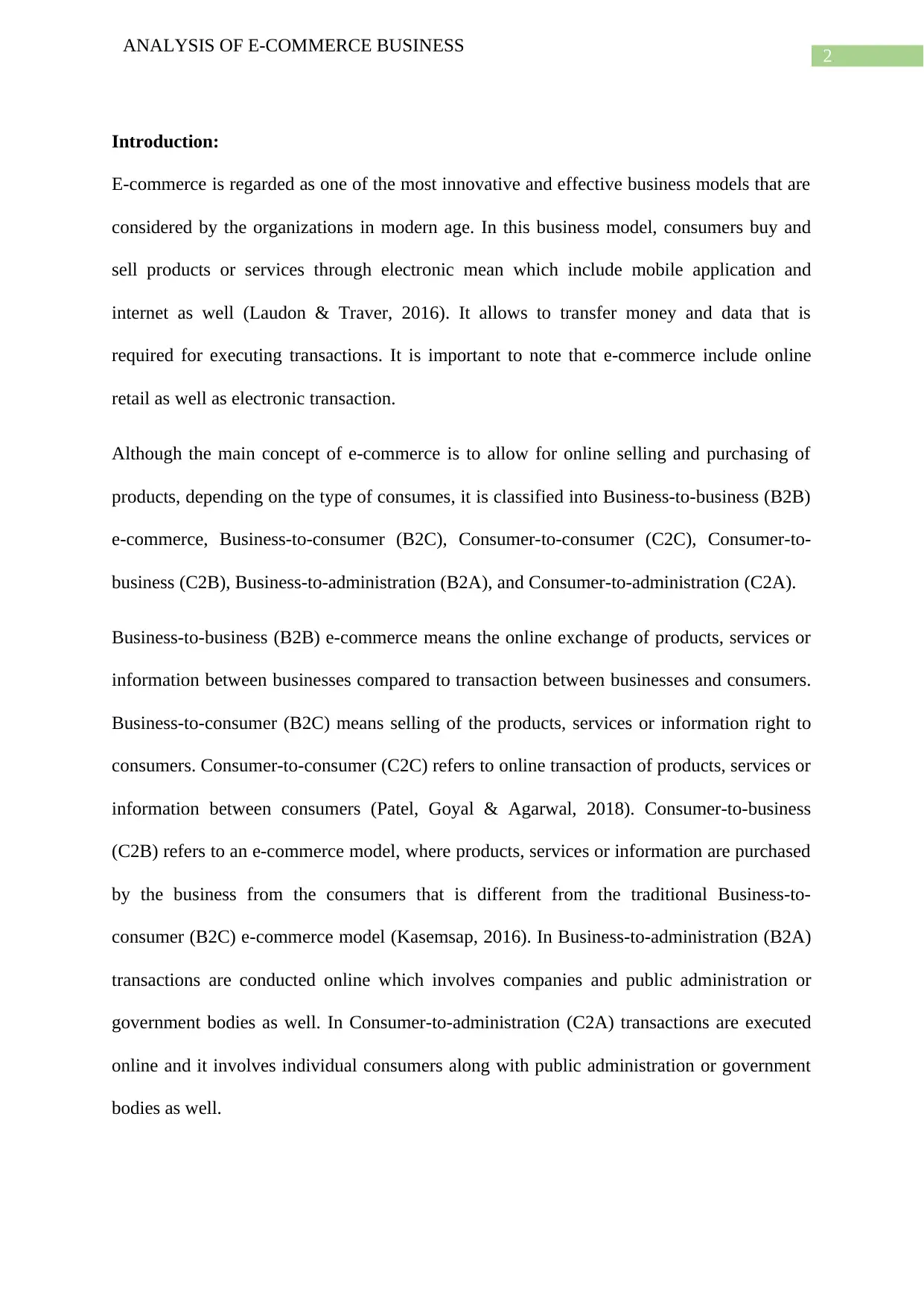
2
ANALYSIS OF E-COMMERCE BUSINESS
Introduction:
E-commerce is regarded as one of the most innovative and effective business models that are
considered by the organizations in modern age. In this business model, consumers buy and
sell products or services through electronic mean which include mobile application and
internet as well (Laudon & Traver, 2016). It allows to transfer money and data that is
required for executing transactions. It is important to note that e-commerce include online
retail as well as electronic transaction.
Although the main concept of e-commerce is to allow for online selling and purchasing of
products, depending on the type of consumes, it is classified into Business-to-business (B2B)
e-commerce, Business-to-consumer (B2C), Consumer-to-consumer (C2C), Consumer-to-
business (C2B), Business-to-administration (B2A), and Consumer-to-administration (C2A).
Business-to-business (B2B) e-commerce means the online exchange of products, services or
information between businesses compared to transaction between businesses and consumers.
Business-to-consumer (B2C) means selling of the products, services or information right to
consumers. Consumer-to-consumer (C2C) refers to online transaction of products, services or
information between consumers (Patel, Goyal & Agarwal, 2018). Consumer-to-business
(C2B) refers to an e-commerce model, where products, services or information are purchased
by the business from the consumers that is different from the traditional Business-to-
consumer (B2C) e-commerce model (Kasemsap, 2016). In Business-to-administration (B2A)
transactions are conducted online which involves companies and public administration or
government bodies as well. In Consumer-to-administration (C2A) transactions are executed
online and it involves individual consumers along with public administration or government
bodies as well.
ANALYSIS OF E-COMMERCE BUSINESS
Introduction:
E-commerce is regarded as one of the most innovative and effective business models that are
considered by the organizations in modern age. In this business model, consumers buy and
sell products or services through electronic mean which include mobile application and
internet as well (Laudon & Traver, 2016). It allows to transfer money and data that is
required for executing transactions. It is important to note that e-commerce include online
retail as well as electronic transaction.
Although the main concept of e-commerce is to allow for online selling and purchasing of
products, depending on the type of consumes, it is classified into Business-to-business (B2B)
e-commerce, Business-to-consumer (B2C), Consumer-to-consumer (C2C), Consumer-to-
business (C2B), Business-to-administration (B2A), and Consumer-to-administration (C2A).
Business-to-business (B2B) e-commerce means the online exchange of products, services or
information between businesses compared to transaction between businesses and consumers.
Business-to-consumer (B2C) means selling of the products, services or information right to
consumers. Consumer-to-consumer (C2C) refers to online transaction of products, services or
information between consumers (Patel, Goyal & Agarwal, 2018). Consumer-to-business
(C2B) refers to an e-commerce model, where products, services or information are purchased
by the business from the consumers that is different from the traditional Business-to-
consumer (B2C) e-commerce model (Kasemsap, 2016). In Business-to-administration (B2A)
transactions are conducted online which involves companies and public administration or
government bodies as well. In Consumer-to-administration (C2A) transactions are executed
online and it involves individual consumers along with public administration or government
bodies as well.
⊘ This is a preview!⊘
Do you want full access?
Subscribe today to unlock all pages.

Trusted by 1+ million students worldwide
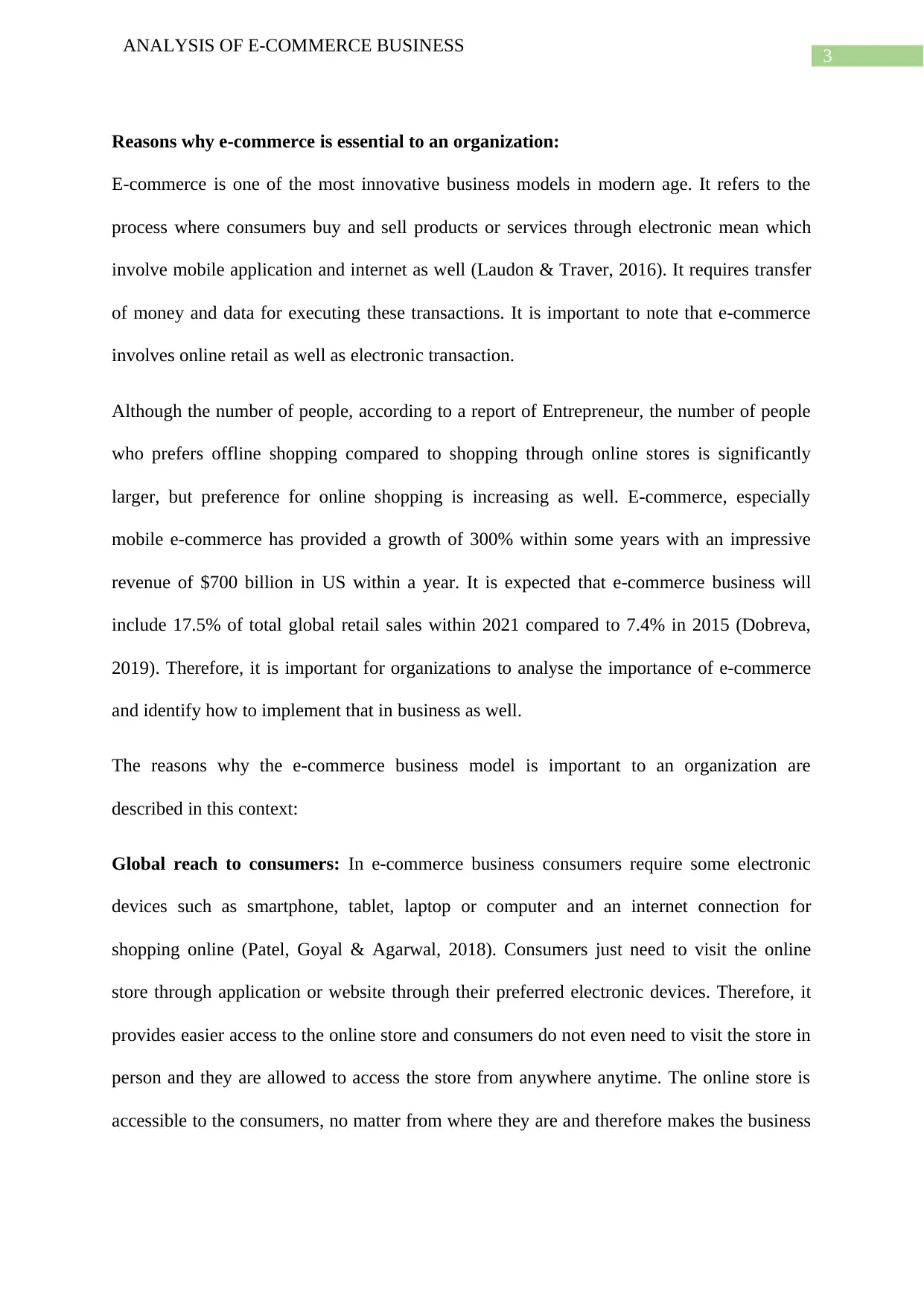
3
ANALYSIS OF E-COMMERCE BUSINESS
Reasons why e-commerce is essential to an organization:
E-commerce is one of the most innovative business models in modern age. It refers to the
process where consumers buy and sell products or services through electronic mean which
involve mobile application and internet as well (Laudon & Traver, 2016). It requires transfer
of money and data for executing these transactions. It is important to note that e-commerce
involves online retail as well as electronic transaction.
Although the number of people, according to a report of Entrepreneur, the number of people
who prefers offline shopping compared to shopping through online stores is significantly
larger, but preference for online shopping is increasing as well. E-commerce, especially
mobile e-commerce has provided a growth of 300% within some years with an impressive
revenue of $700 billion in US within a year. It is expected that e-commerce business will
include 17.5% of total global retail sales within 2021 compared to 7.4% in 2015 (Dobreva,
2019). Therefore, it is important for organizations to analyse the importance of e-commerce
and identify how to implement that in business as well.
The reasons why the e-commerce business model is important to an organization are
described in this context:
Global reach to consumers: In e-commerce business consumers require some electronic
devices such as smartphone, tablet, laptop or computer and an internet connection for
shopping online (Patel, Goyal & Agarwal, 2018). Consumers just need to visit the online
store through application or website through their preferred electronic devices. Therefore, it
provides easier access to the online store and consumers do not even need to visit the store in
person and they are allowed to access the store from anywhere anytime. The online store is
accessible to the consumers, no matter from where they are and therefore makes the business
ANALYSIS OF E-COMMERCE BUSINESS
Reasons why e-commerce is essential to an organization:
E-commerce is one of the most innovative business models in modern age. It refers to the
process where consumers buy and sell products or services through electronic mean which
involve mobile application and internet as well (Laudon & Traver, 2016). It requires transfer
of money and data for executing these transactions. It is important to note that e-commerce
involves online retail as well as electronic transaction.
Although the number of people, according to a report of Entrepreneur, the number of people
who prefers offline shopping compared to shopping through online stores is significantly
larger, but preference for online shopping is increasing as well. E-commerce, especially
mobile e-commerce has provided a growth of 300% within some years with an impressive
revenue of $700 billion in US within a year. It is expected that e-commerce business will
include 17.5% of total global retail sales within 2021 compared to 7.4% in 2015 (Dobreva,
2019). Therefore, it is important for organizations to analyse the importance of e-commerce
and identify how to implement that in business as well.
The reasons why the e-commerce business model is important to an organization are
described in this context:
Global reach to consumers: In e-commerce business consumers require some electronic
devices such as smartphone, tablet, laptop or computer and an internet connection for
shopping online (Patel, Goyal & Agarwal, 2018). Consumers just need to visit the online
store through application or website through their preferred electronic devices. Therefore, it
provides easier access to the online store and consumers do not even need to visit the store in
person and they are allowed to access the store from anywhere anytime. The online store is
accessible to the consumers, no matter from where they are and therefore makes the business
Paraphrase This Document
Need a fresh take? Get an instant paraphrase of this document with our AI Paraphraser
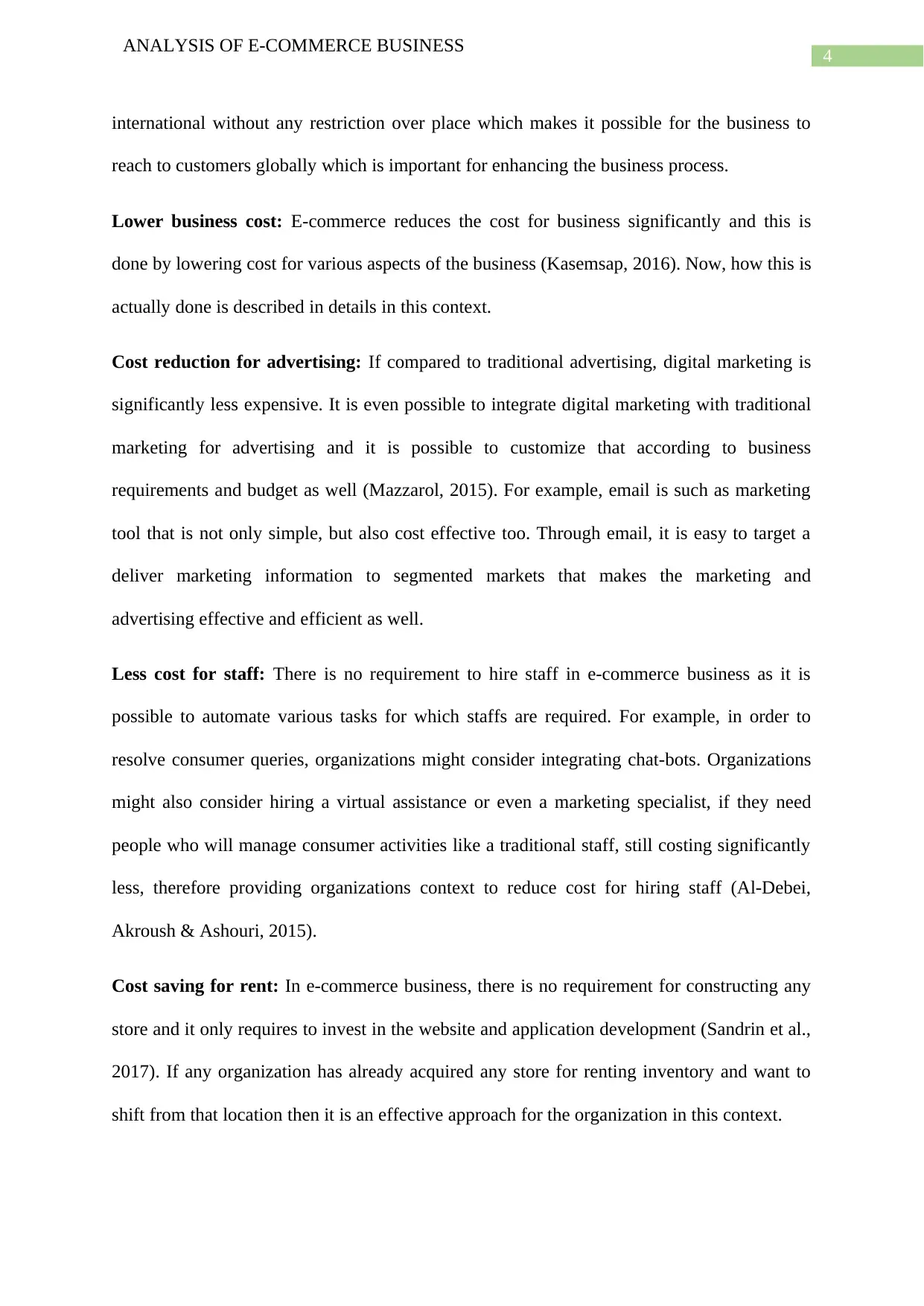
4
ANALYSIS OF E-COMMERCE BUSINESS
international without any restriction over place which makes it possible for the business to
reach to customers globally which is important for enhancing the business process.
Lower business cost: E-commerce reduces the cost for business significantly and this is
done by lowering cost for various aspects of the business (Kasemsap, 2016). Now, how this is
actually done is described in details in this context.
Cost reduction for advertising: If compared to traditional advertising, digital marketing is
significantly less expensive. It is even possible to integrate digital marketing with traditional
marketing for advertising and it is possible to customize that according to business
requirements and budget as well (Mazzarol, 2015). For example, email is such as marketing
tool that is not only simple, but also cost effective too. Through email, it is easy to target a
deliver marketing information to segmented markets that makes the marketing and
advertising effective and efficient as well.
Less cost for staff: There is no requirement to hire staff in e-commerce business as it is
possible to automate various tasks for which staffs are required. For example, in order to
resolve consumer queries, organizations might consider integrating chat-bots. Organizations
might also consider hiring a virtual assistance or even a marketing specialist, if they need
people who will manage consumer activities like a traditional staff, still costing significantly
less, therefore providing organizations context to reduce cost for hiring staff (Al-Debei,
Akroush & Ashouri, 2015).
Cost saving for rent: In e-commerce business, there is no requirement for constructing any
store and it only requires to invest in the website and application development (Sandrin et al.,
2017). If any organization has already acquired any store for renting inventory and want to
shift from that location then it is an effective approach for the organization in this context.
ANALYSIS OF E-COMMERCE BUSINESS
international without any restriction over place which makes it possible for the business to
reach to customers globally which is important for enhancing the business process.
Lower business cost: E-commerce reduces the cost for business significantly and this is
done by lowering cost for various aspects of the business (Kasemsap, 2016). Now, how this is
actually done is described in details in this context.
Cost reduction for advertising: If compared to traditional advertising, digital marketing is
significantly less expensive. It is even possible to integrate digital marketing with traditional
marketing for advertising and it is possible to customize that according to business
requirements and budget as well (Mazzarol, 2015). For example, email is such as marketing
tool that is not only simple, but also cost effective too. Through email, it is easy to target a
deliver marketing information to segmented markets that makes the marketing and
advertising effective and efficient as well.
Less cost for staff: There is no requirement to hire staff in e-commerce business as it is
possible to automate various tasks for which staffs are required. For example, in order to
resolve consumer queries, organizations might consider integrating chat-bots. Organizations
might also consider hiring a virtual assistance or even a marketing specialist, if they need
people who will manage consumer activities like a traditional staff, still costing significantly
less, therefore providing organizations context to reduce cost for hiring staff (Al-Debei,
Akroush & Ashouri, 2015).
Cost saving for rent: In e-commerce business, there is no requirement for constructing any
store and it only requires to invest in the website and application development (Sandrin et al.,
2017). If any organization has already acquired any store for renting inventory and want to
shift from that location then it is an effective approach for the organization in this context.
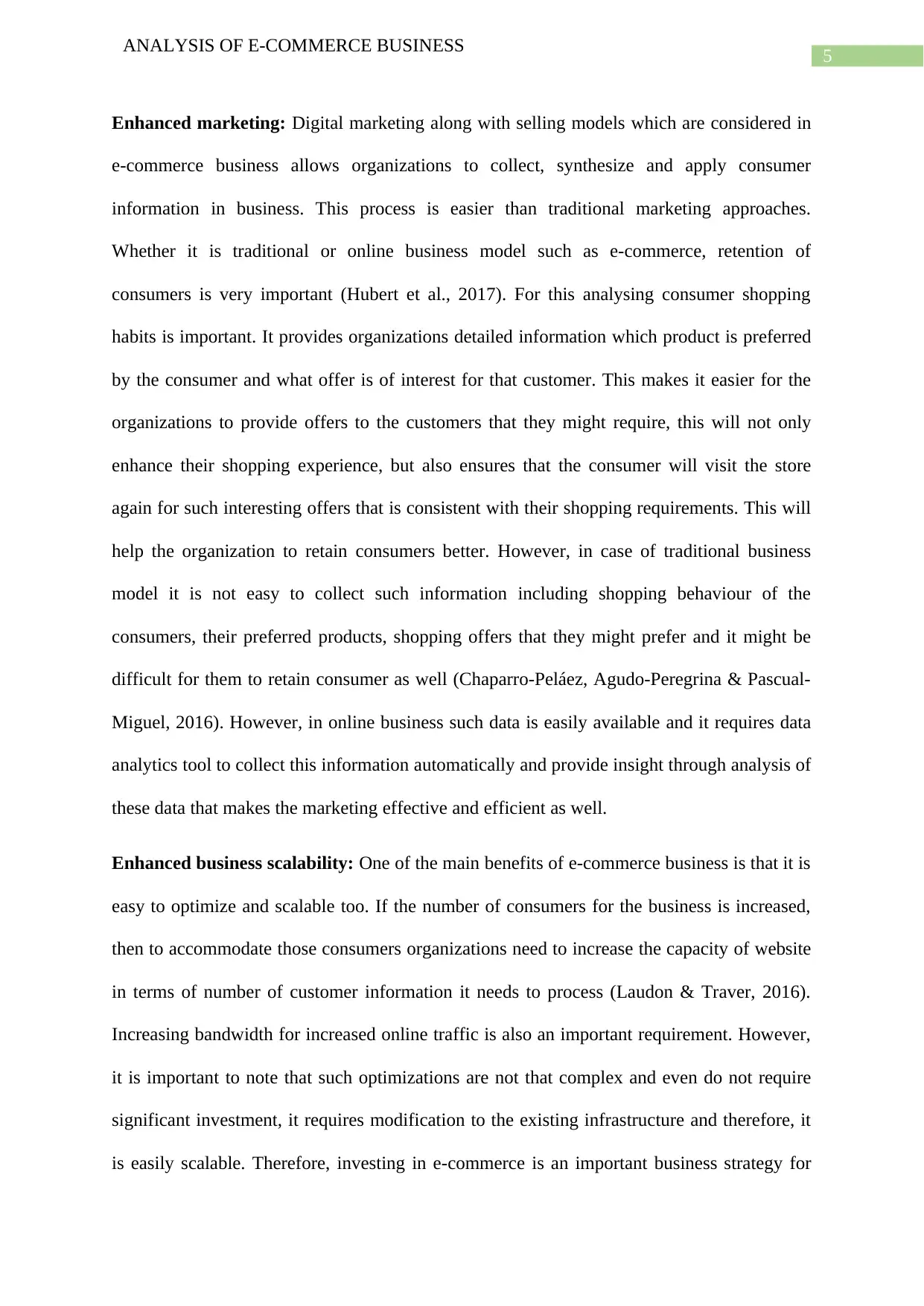
5
ANALYSIS OF E-COMMERCE BUSINESS
Enhanced marketing: Digital marketing along with selling models which are considered in
e-commerce business allows organizations to collect, synthesize and apply consumer
information in business. This process is easier than traditional marketing approaches.
Whether it is traditional or online business model such as e-commerce, retention of
consumers is very important (Hubert et al., 2017). For this analysing consumer shopping
habits is important. It provides organizations detailed information which product is preferred
by the consumer and what offer is of interest for that customer. This makes it easier for the
organizations to provide offers to the customers that they might require, this will not only
enhance their shopping experience, but also ensures that the consumer will visit the store
again for such interesting offers that is consistent with their shopping requirements. This will
help the organization to retain consumers better. However, in case of traditional business
model it is not easy to collect such information including shopping behaviour of the
consumers, their preferred products, shopping offers that they might prefer and it might be
difficult for them to retain consumer as well (Chaparro-Peláez, Agudo-Peregrina & Pascual-
Miguel, 2016). However, in online business such data is easily available and it requires data
analytics tool to collect this information automatically and provide insight through analysis of
these data that makes the marketing effective and efficient as well.
Enhanced business scalability: One of the main benefits of e-commerce business is that it is
easy to optimize and scalable too. If the number of consumers for the business is increased,
then to accommodate those consumers organizations need to increase the capacity of website
in terms of number of customer information it needs to process (Laudon & Traver, 2016).
Increasing bandwidth for increased online traffic is also an important requirement. However,
it is important to note that such optimizations are not that complex and even do not require
significant investment, it requires modification to the existing infrastructure and therefore, it
is easily scalable. Therefore, investing in e-commerce is an important business strategy for
ANALYSIS OF E-COMMERCE BUSINESS
Enhanced marketing: Digital marketing along with selling models which are considered in
e-commerce business allows organizations to collect, synthesize and apply consumer
information in business. This process is easier than traditional marketing approaches.
Whether it is traditional or online business model such as e-commerce, retention of
consumers is very important (Hubert et al., 2017). For this analysing consumer shopping
habits is important. It provides organizations detailed information which product is preferred
by the consumer and what offer is of interest for that customer. This makes it easier for the
organizations to provide offers to the customers that they might require, this will not only
enhance their shopping experience, but also ensures that the consumer will visit the store
again for such interesting offers that is consistent with their shopping requirements. This will
help the organization to retain consumers better. However, in case of traditional business
model it is not easy to collect such information including shopping behaviour of the
consumers, their preferred products, shopping offers that they might prefer and it might be
difficult for them to retain consumer as well (Chaparro-Peláez, Agudo-Peregrina & Pascual-
Miguel, 2016). However, in online business such data is easily available and it requires data
analytics tool to collect this information automatically and provide insight through analysis of
these data that makes the marketing effective and efficient as well.
Enhanced business scalability: One of the main benefits of e-commerce business is that it is
easy to optimize and scalable too. If the number of consumers for the business is increased,
then to accommodate those consumers organizations need to increase the capacity of website
in terms of number of customer information it needs to process (Laudon & Traver, 2016).
Increasing bandwidth for increased online traffic is also an important requirement. However,
it is important to note that such optimizations are not that complex and even do not require
significant investment, it requires modification to the existing infrastructure and therefore, it
is easily scalable. Therefore, investing in e-commerce is an important business strategy for
⊘ This is a preview!⊘
Do you want full access?
Subscribe today to unlock all pages.

Trusted by 1+ million students worldwide
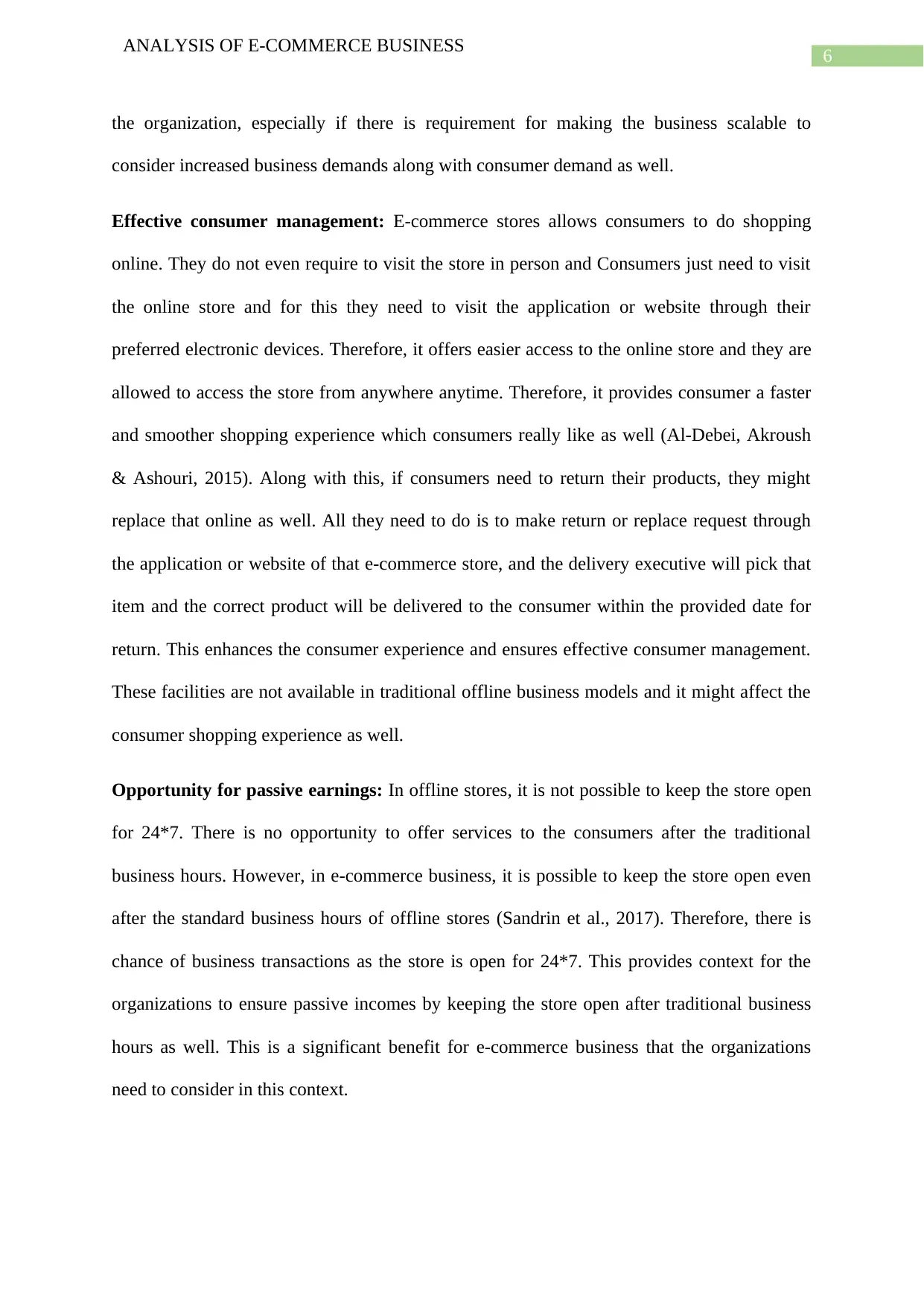
6
ANALYSIS OF E-COMMERCE BUSINESS
the organization, especially if there is requirement for making the business scalable to
consider increased business demands along with consumer demand as well.
Effective consumer management: E-commerce stores allows consumers to do shopping
online. They do not even require to visit the store in person and Consumers just need to visit
the online store and for this they need to visit the application or website through their
preferred electronic devices. Therefore, it offers easier access to the online store and they are
allowed to access the store from anywhere anytime. Therefore, it provides consumer a faster
and smoother shopping experience which consumers really like as well (Al-Debei, Akroush
& Ashouri, 2015). Along with this, if consumers need to return their products, they might
replace that online as well. All they need to do is to make return or replace request through
the application or website of that e-commerce store, and the delivery executive will pick that
item and the correct product will be delivered to the consumer within the provided date for
return. This enhances the consumer experience and ensures effective consumer management.
These facilities are not available in traditional offline business models and it might affect the
consumer shopping experience as well.
Opportunity for passive earnings: In offline stores, it is not possible to keep the store open
for 24*7. There is no opportunity to offer services to the consumers after the traditional
business hours. However, in e-commerce business, it is possible to keep the store open even
after the standard business hours of offline stores (Sandrin et al., 2017). Therefore, there is
chance of business transactions as the store is open for 24*7. This provides context for the
organizations to ensure passive incomes by keeping the store open after traditional business
hours as well. This is a significant benefit for e-commerce business that the organizations
need to consider in this context.
ANALYSIS OF E-COMMERCE BUSINESS
the organization, especially if there is requirement for making the business scalable to
consider increased business demands along with consumer demand as well.
Effective consumer management: E-commerce stores allows consumers to do shopping
online. They do not even require to visit the store in person and Consumers just need to visit
the online store and for this they need to visit the application or website through their
preferred electronic devices. Therefore, it offers easier access to the online store and they are
allowed to access the store from anywhere anytime. Therefore, it provides consumer a faster
and smoother shopping experience which consumers really like as well (Al-Debei, Akroush
& Ashouri, 2015). Along with this, if consumers need to return their products, they might
replace that online as well. All they need to do is to make return or replace request through
the application or website of that e-commerce store, and the delivery executive will pick that
item and the correct product will be delivered to the consumer within the provided date for
return. This enhances the consumer experience and ensures effective consumer management.
These facilities are not available in traditional offline business models and it might affect the
consumer shopping experience as well.
Opportunity for passive earnings: In offline stores, it is not possible to keep the store open
for 24*7. There is no opportunity to offer services to the consumers after the traditional
business hours. However, in e-commerce business, it is possible to keep the store open even
after the standard business hours of offline stores (Sandrin et al., 2017). Therefore, there is
chance of business transactions as the store is open for 24*7. This provides context for the
organizations to ensure passive incomes by keeping the store open after traditional business
hours as well. This is a significant benefit for e-commerce business that the organizations
need to consider in this context.
Paraphrase This Document
Need a fresh take? Get an instant paraphrase of this document with our AI Paraphraser
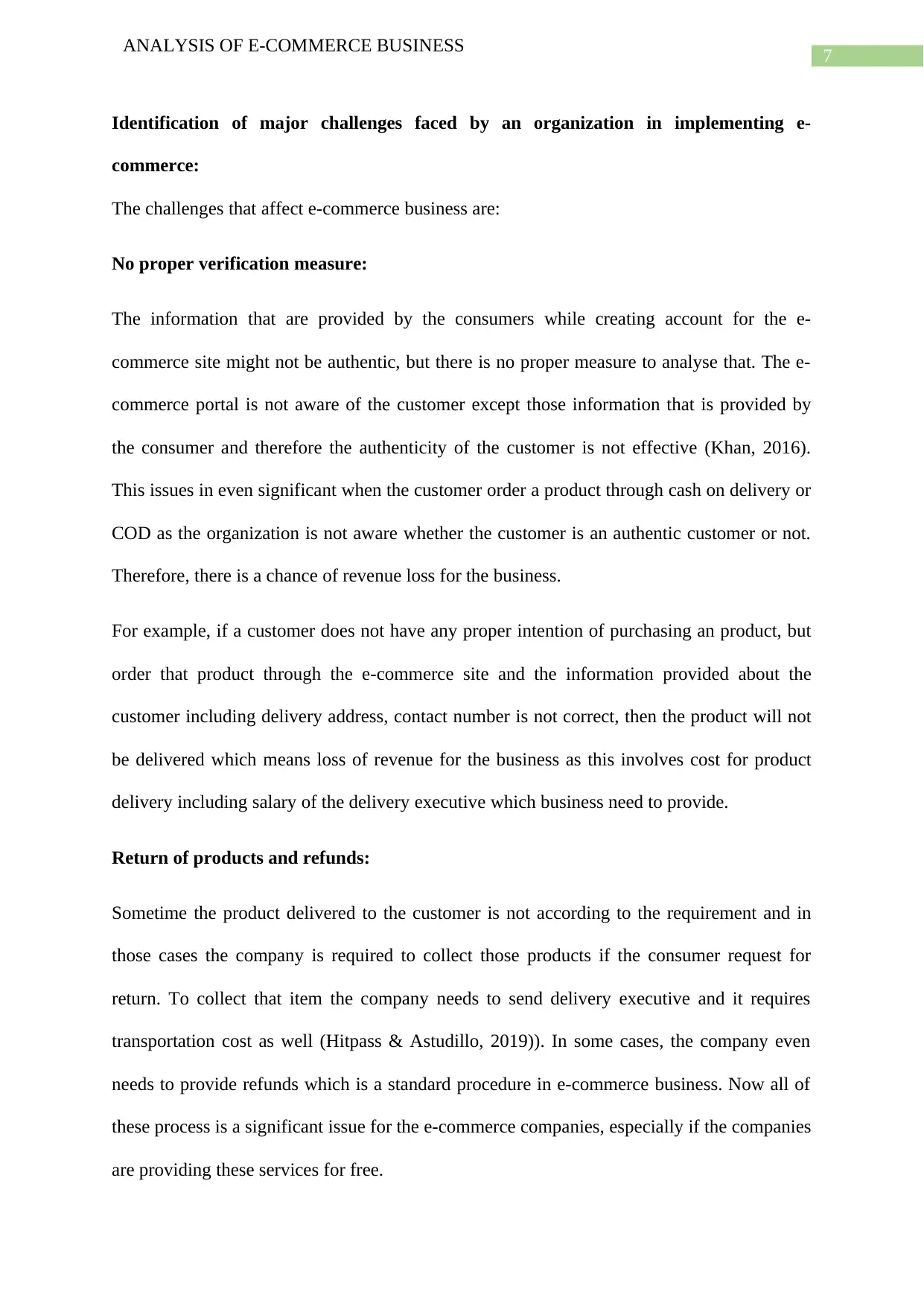
7
ANALYSIS OF E-COMMERCE BUSINESS
Identification of major challenges faced by an organization in implementing e-
commerce:
The challenges that affect e-commerce business are:
No proper verification measure:
The information that are provided by the consumers while creating account for the e-
commerce site might not be authentic, but there is no proper measure to analyse that. The e-
commerce portal is not aware of the customer except those information that is provided by
the consumer and therefore the authenticity of the customer is not effective (Khan, 2016).
This issues in even significant when the customer order a product through cash on delivery or
COD as the organization is not aware whether the customer is an authentic customer or not.
Therefore, there is a chance of revenue loss for the business.
For example, if a customer does not have any proper intention of purchasing an product, but
order that product through the e-commerce site and the information provided about the
customer including delivery address, contact number is not correct, then the product will not
be delivered which means loss of revenue for the business as this involves cost for product
delivery including salary of the delivery executive which business need to provide.
Return of products and refunds:
Sometime the product delivered to the customer is not according to the requirement and in
those cases the company is required to collect those products if the consumer request for
return. To collect that item the company needs to send delivery executive and it requires
transportation cost as well (Hitpass & Astudillo, 2019)). In some cases, the company even
needs to provide refunds which is a standard procedure in e-commerce business. Now all of
these process is a significant issue for the e-commerce companies, especially if the companies
are providing these services for free.
ANALYSIS OF E-COMMERCE BUSINESS
Identification of major challenges faced by an organization in implementing e-
commerce:
The challenges that affect e-commerce business are:
No proper verification measure:
The information that are provided by the consumers while creating account for the e-
commerce site might not be authentic, but there is no proper measure to analyse that. The e-
commerce portal is not aware of the customer except those information that is provided by
the consumer and therefore the authenticity of the customer is not effective (Khan, 2016).
This issues in even significant when the customer order a product through cash on delivery or
COD as the organization is not aware whether the customer is an authentic customer or not.
Therefore, there is a chance of revenue loss for the business.
For example, if a customer does not have any proper intention of purchasing an product, but
order that product through the e-commerce site and the information provided about the
customer including delivery address, contact number is not correct, then the product will not
be delivered which means loss of revenue for the business as this involves cost for product
delivery including salary of the delivery executive which business need to provide.
Return of products and refunds:
Sometime the product delivered to the customer is not according to the requirement and in
those cases the company is required to collect those products if the consumer request for
return. To collect that item the company needs to send delivery executive and it requires
transportation cost as well (Hitpass & Astudillo, 2019)). In some cases, the company even
needs to provide refunds which is a standard procedure in e-commerce business. Now all of
these process is a significant issue for the e-commerce companies, especially if the companies
are providing these services for free.
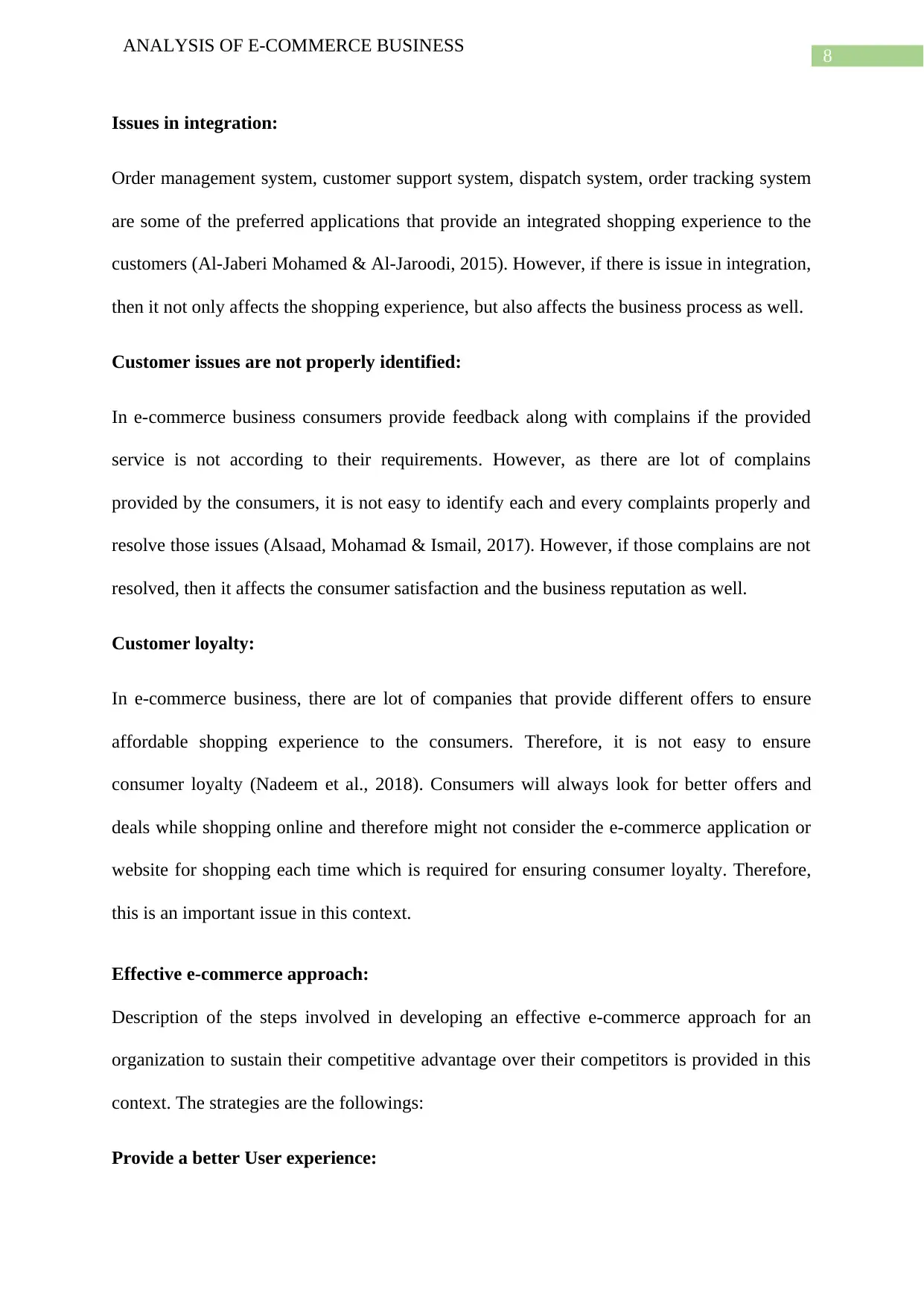
8
ANALYSIS OF E-COMMERCE BUSINESS
Issues in integration:
Order management system, customer support system, dispatch system, order tracking system
are some of the preferred applications that provide an integrated shopping experience to the
customers (Al-Jaberi Mohamed & Al-Jaroodi, 2015). However, if there is issue in integration,
then it not only affects the shopping experience, but also affects the business process as well.
Customer issues are not properly identified:
In e-commerce business consumers provide feedback along with complains if the provided
service is not according to their requirements. However, as there are lot of complains
provided by the consumers, it is not easy to identify each and every complaints properly and
resolve those issues (Alsaad, Mohamad & Ismail, 2017). However, if those complains are not
resolved, then it affects the consumer satisfaction and the business reputation as well.
Customer loyalty:
In e-commerce business, there are lot of companies that provide different offers to ensure
affordable shopping experience to the consumers. Therefore, it is not easy to ensure
consumer loyalty (Nadeem et al., 2018). Consumers will always look for better offers and
deals while shopping online and therefore might not consider the e-commerce application or
website for shopping each time which is required for ensuring consumer loyalty. Therefore,
this is an important issue in this context.
Effective e-commerce approach:
Description of the steps involved in developing an effective e-commerce approach for an
organization to sustain their competitive advantage over their competitors is provided in this
context. The strategies are the followings:
Provide a better User experience:
ANALYSIS OF E-COMMERCE BUSINESS
Issues in integration:
Order management system, customer support system, dispatch system, order tracking system
are some of the preferred applications that provide an integrated shopping experience to the
customers (Al-Jaberi Mohamed & Al-Jaroodi, 2015). However, if there is issue in integration,
then it not only affects the shopping experience, but also affects the business process as well.
Customer issues are not properly identified:
In e-commerce business consumers provide feedback along with complains if the provided
service is not according to their requirements. However, as there are lot of complains
provided by the consumers, it is not easy to identify each and every complaints properly and
resolve those issues (Alsaad, Mohamad & Ismail, 2017). However, if those complains are not
resolved, then it affects the consumer satisfaction and the business reputation as well.
Customer loyalty:
In e-commerce business, there are lot of companies that provide different offers to ensure
affordable shopping experience to the consumers. Therefore, it is not easy to ensure
consumer loyalty (Nadeem et al., 2018). Consumers will always look for better offers and
deals while shopping online and therefore might not consider the e-commerce application or
website for shopping each time which is required for ensuring consumer loyalty. Therefore,
this is an important issue in this context.
Effective e-commerce approach:
Description of the steps involved in developing an effective e-commerce approach for an
organization to sustain their competitive advantage over their competitors is provided in this
context. The strategies are the followings:
Provide a better User experience:
⊘ This is a preview!⊘
Do you want full access?
Subscribe today to unlock all pages.

Trusted by 1+ million students worldwide
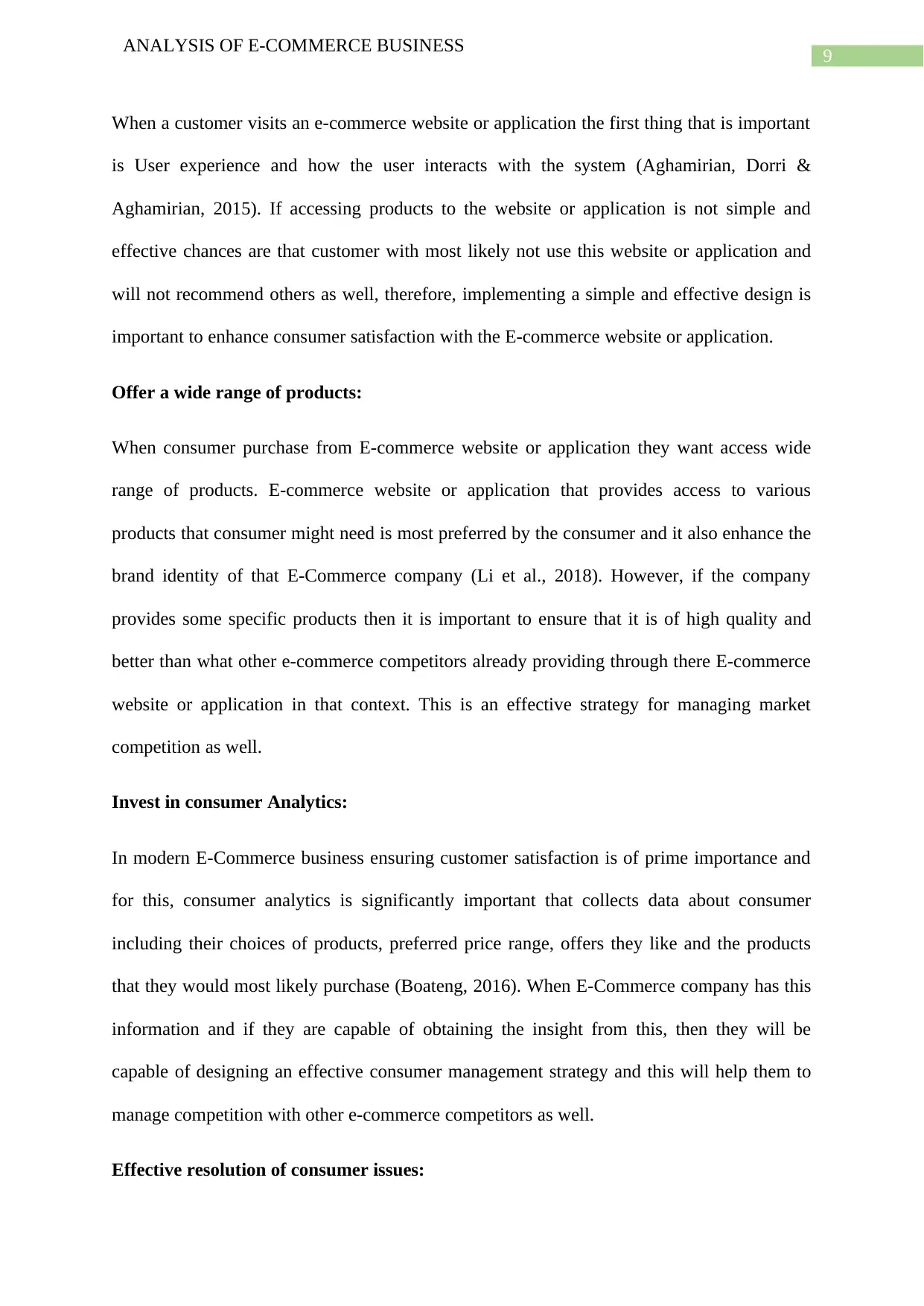
9
ANALYSIS OF E-COMMERCE BUSINESS
When a customer visits an e-commerce website or application the first thing that is important
is User experience and how the user interacts with the system (Aghamirian, Dorri &
Aghamirian, 2015). If accessing products to the website or application is not simple and
effective chances are that customer with most likely not use this website or application and
will not recommend others as well, therefore, implementing a simple and effective design is
important to enhance consumer satisfaction with the E-commerce website or application.
Offer a wide range of products:
When consumer purchase from E-commerce website or application they want access wide
range of products. E-commerce website or application that provides access to various
products that consumer might need is most preferred by the consumer and it also enhance the
brand identity of that E-Commerce company (Li et al., 2018). However, if the company
provides some specific products then it is important to ensure that it is of high quality and
better than what other e-commerce competitors already providing through there E-commerce
website or application in that context. This is an effective strategy for managing market
competition as well.
Invest in consumer Analytics:
In modern E-Commerce business ensuring customer satisfaction is of prime importance and
for this, consumer analytics is significantly important that collects data about consumer
including their choices of products, preferred price range, offers they like and the products
that they would most likely purchase (Boateng, 2016). When E-Commerce company has this
information and if they are capable of obtaining the insight from this, then they will be
capable of designing an effective consumer management strategy and this will help them to
manage competition with other e-commerce competitors as well.
Effective resolution of consumer issues:
ANALYSIS OF E-COMMERCE BUSINESS
When a customer visits an e-commerce website or application the first thing that is important
is User experience and how the user interacts with the system (Aghamirian, Dorri &
Aghamirian, 2015). If accessing products to the website or application is not simple and
effective chances are that customer with most likely not use this website or application and
will not recommend others as well, therefore, implementing a simple and effective design is
important to enhance consumer satisfaction with the E-commerce website or application.
Offer a wide range of products:
When consumer purchase from E-commerce website or application they want access wide
range of products. E-commerce website or application that provides access to various
products that consumer might need is most preferred by the consumer and it also enhance the
brand identity of that E-Commerce company (Li et al., 2018). However, if the company
provides some specific products then it is important to ensure that it is of high quality and
better than what other e-commerce competitors already providing through there E-commerce
website or application in that context. This is an effective strategy for managing market
competition as well.
Invest in consumer Analytics:
In modern E-Commerce business ensuring customer satisfaction is of prime importance and
for this, consumer analytics is significantly important that collects data about consumer
including their choices of products, preferred price range, offers they like and the products
that they would most likely purchase (Boateng, 2016). When E-Commerce company has this
information and if they are capable of obtaining the insight from this, then they will be
capable of designing an effective consumer management strategy and this will help them to
manage competition with other e-commerce competitors as well.
Effective resolution of consumer issues:
Paraphrase This Document
Need a fresh take? Get an instant paraphrase of this document with our AI Paraphraser

10
ANALYSIS OF E-COMMERCE BUSINESS
In order to ensure consumer satisfaction and engage them with the business it is important to
resolve their queries including purchase issues, delivery of products, return of products and
other issues related to purchasing through the E-commerce website or application
(Aghamirian, Dorri & Aghamirian, 2015). Therefore, providing virtual assistant to interact
with the customer whenever they require is an effective strategy in this context.
ANALYSIS OF E-COMMERCE BUSINESS
In order to ensure consumer satisfaction and engage them with the business it is important to
resolve their queries including purchase issues, delivery of products, return of products and
other issues related to purchasing through the E-commerce website or application
(Aghamirian, Dorri & Aghamirian, 2015). Therefore, providing virtual assistant to interact
with the customer whenever they require is an effective strategy in this context.
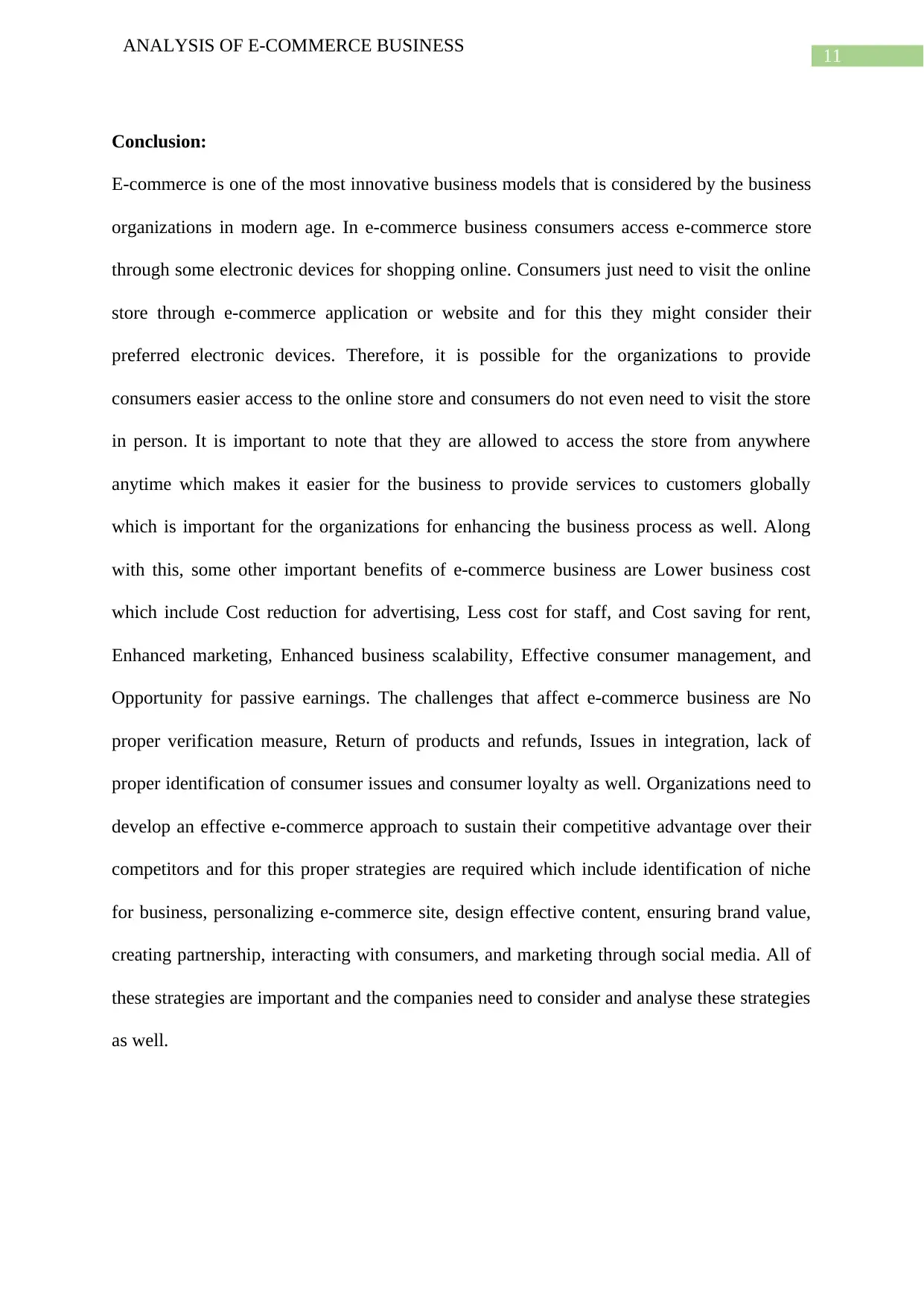
11
ANALYSIS OF E-COMMERCE BUSINESS
Conclusion:
E-commerce is one of the most innovative business models that is considered by the business
organizations in modern age. In e-commerce business consumers access e-commerce store
through some electronic devices for shopping online. Consumers just need to visit the online
store through e-commerce application or website and for this they might consider their
preferred electronic devices. Therefore, it is possible for the organizations to provide
consumers easier access to the online store and consumers do not even need to visit the store
in person. It is important to note that they are allowed to access the store from anywhere
anytime which makes it easier for the business to provide services to customers globally
which is important for the organizations for enhancing the business process as well. Along
with this, some other important benefits of e-commerce business are Lower business cost
which include Cost reduction for advertising, Less cost for staff, and Cost saving for rent,
Enhanced marketing, Enhanced business scalability, Effective consumer management, and
Opportunity for passive earnings. The challenges that affect e-commerce business are No
proper verification measure, Return of products and refunds, Issues in integration, lack of
proper identification of consumer issues and consumer loyalty as well. Organizations need to
develop an effective e-commerce approach to sustain their competitive advantage over their
competitors and for this proper strategies are required which include identification of niche
for business, personalizing e-commerce site, design effective content, ensuring brand value,
creating partnership, interacting with consumers, and marketing through social media. All of
these strategies are important and the companies need to consider and analyse these strategies
as well.
ANALYSIS OF E-COMMERCE BUSINESS
Conclusion:
E-commerce is one of the most innovative business models that is considered by the business
organizations in modern age. In e-commerce business consumers access e-commerce store
through some electronic devices for shopping online. Consumers just need to visit the online
store through e-commerce application or website and for this they might consider their
preferred electronic devices. Therefore, it is possible for the organizations to provide
consumers easier access to the online store and consumers do not even need to visit the store
in person. It is important to note that they are allowed to access the store from anywhere
anytime which makes it easier for the business to provide services to customers globally
which is important for the organizations for enhancing the business process as well. Along
with this, some other important benefits of e-commerce business are Lower business cost
which include Cost reduction for advertising, Less cost for staff, and Cost saving for rent,
Enhanced marketing, Enhanced business scalability, Effective consumer management, and
Opportunity for passive earnings. The challenges that affect e-commerce business are No
proper verification measure, Return of products and refunds, Issues in integration, lack of
proper identification of consumer issues and consumer loyalty as well. Organizations need to
develop an effective e-commerce approach to sustain their competitive advantage over their
competitors and for this proper strategies are required which include identification of niche
for business, personalizing e-commerce site, design effective content, ensuring brand value,
creating partnership, interacting with consumers, and marketing through social media. All of
these strategies are important and the companies need to consider and analyse these strategies
as well.
⊘ This is a preview!⊘
Do you want full access?
Subscribe today to unlock all pages.

Trusted by 1+ million students worldwide
1 out of 15
Related Documents
Your All-in-One AI-Powered Toolkit for Academic Success.
+13062052269
info@desklib.com
Available 24*7 on WhatsApp / Email
![[object Object]](/_next/static/media/star-bottom.7253800d.svg)
Unlock your academic potential
Copyright © 2020–2025 A2Z Services. All Rights Reserved. Developed and managed by ZUCOL.



